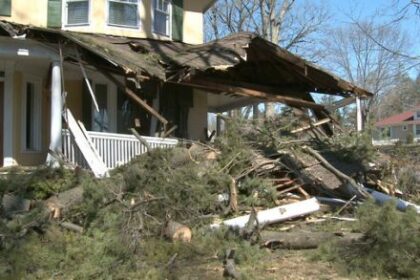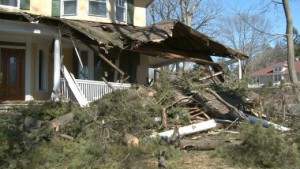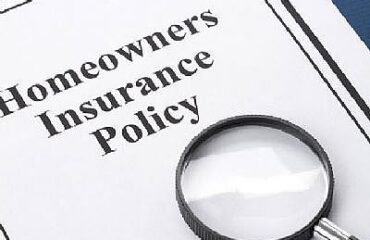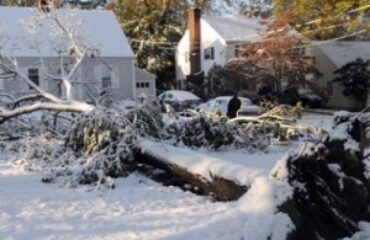
 After one of the largest snowstorms in decades, the Northeast will now be without power for a third day. This snow storm has brought down trees and power lines, and knocking out electricity to customers in Connecticut, New York, and New Jersey. The damage is now widespread and could possibly take a week to regain energy. The storm spread wind, rain and snow from West Virginia to Maine. Wet, heavy snow fell on trees that hadn’t yet shed their leaves, causing branches to break and bring down power lines and damage roofs of homes.
After one of the largest snowstorms in decades, the Northeast will now be without power for a third day. This snow storm has brought down trees and power lines, and knocking out electricity to customers in Connecticut, New York, and New Jersey. The damage is now widespread and could possibly take a week to regain energy. The storm spread wind, rain and snow from West Virginia to Maine. Wet, heavy snow fell on trees that hadn’t yet shed their leaves, causing branches to break and bring down power lines and damage roofs of homes.
Many people, aside from having no power, have damage to their homes because of this terrible storm. As a policy holder it is important to know what is covered under your policy. Many people are unaware of things that you can claim from your insurance such as food loss or loss of use. It’s important to understand your policy and if it includes damage caused by snow, hail, ice and sleet. It may also cover the occasional plumbing problems, frozen pipes, and power outages. Contact a public adjuster to get claim help and understanding of how they can assist you to recover from your loss.
Below are some tips from NJ Office of Emergency Management pertaining to the hazards of power outages and what to do.
- Call your utility to determine area repair schedules.
- Listen to your battery-powered radio or television for updated information, and for any directions from public safety officials.
- Remember: A battery-powered radio is a key part of your Emergency Supply Kit.
- Use only a battery powered light, such as a flashlight, for emergency lighting! Due to the extreme risk of fire, DO NOT use candles during a power outage.
- Avoid elevators.
- Turn off or unplug lights and appliances to prevent a circuit overload when the power returns. Leave one light on to let you know when power has been restored.
- Protect yourself from carbon monoxide poisoning:
- Do not operate generators indoors.
- Do not use charcoal to cook indoors.
- Do not use your gas oven to heat your home.
- All of these activities can cause a deadly buildup of carbon monoxide gas. Use space heaters with proper ventilation.
- Keep your refrigerator and freezer doors closed as much as possible to avoid food spoilage.
- Be sure to check on neighbors, especially the ill, those with electric-dependent medical needs and the elderly.
- If it is cold outside:
- Turn on faucets slightly to prevent pipes from freezing. Running water will not freeze as quickly.
- Put on layers of warm clothing.
- NEVER use your oven as a source of heat!
- If power may be out for a prolonged duration, plan to go to another location that has heat to keep warm.
- During a heat wave:
- Watch for heat-related illnesses, especially in children who may not be able to verbalize how they feel.
- Drink plenty of water, even if you do not feel thirsty.
- Provide plenty of fresh, cool water for your pets.
AFTER A BLACKOUT: WATER TREATMENT
In addition to having a bad odor, and taste, water from questionable sources may be contaminated by a variety of microorganisms, including bacteria and parasites that cause diseases such as dysentery, cholera, typhoid, and hepatitis. All water of uncertain purity should be treated before use.
The American Red Cross recommends the following steps for treating water after a power outage or other emergency, if the water’s purity is uncertain:
- Filter the water using a piece of cloth or coffee filter to remove solid particles.
- Bring it to a rolling boil for about one full minute.
- Let it cool at least 30 minutes. Water must be cool or the chlorine treatment described below will be useless.
- Add 16 drops of liquid chlorine bleach per gallon of water, or 8 drops per 2-liter bottle of water. Stir to mix. Sodium hypochlorite of the concentration of 5.25% to 6% should be the only active ingredient in the bleach. There should not be any added soap or fragrances. A major bleach manufacturer has also added Sodium Hydroxide as an active ingredient, which they state does not pose a health risk for water treatment.
- Let stand 30 minutes.
- If it smells of chlorine, you can use it. If it does not smell of chlorine, add 16 more drops of chlorine bleach per gallon of water (or 8 drops per 2-liter bottle of water), let stand 30 minutes, and smell it again. If it smells of chlorine, you can use it. If it does not smell of chlorine, discard it and find another source of water.
FOOD SAFETY
Remember: Food that has not been refrigerated can cause severe health problems.




